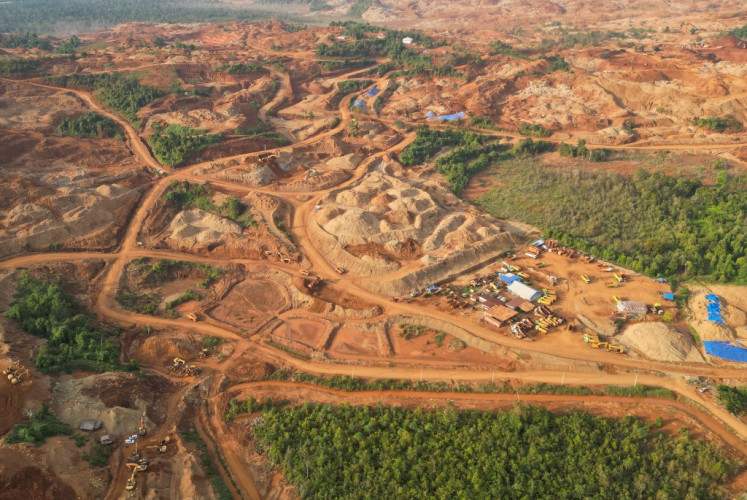Blue ‘bajaj’ bear brunt of stunted CNG growth in Jakarta
Improper parking: A compressed natural gas-powered blue bajaj (three-wheeled motorized vehicles) is parked in a bicycle lane in Blok M, South Jakarta, on Monday, effectively blocking it for cyclists
Change text size
Gift Premium Articles
to Anyone

I
mproper parking: A compressed natural gas-powered blue bajaj (three-wheeled motorized vehicles) is parked in a bicycle lane in Blok M, South Jakarta, on Monday, effectively blocking it for cyclists.(JP/Iqbal Yuwansyah)
The recent image of hundreds of blue bajaj (three-wheeled motorized vehicle) lining up at a compressed natural gas (CNG) station in Jakarta shows how the capital pushed the use of CNG “for cleaner air” only to abandon the effort and let more than 10,000 blue bajaj and 3,000 other CNG-fueled vehicles fend for themselves in filling in their tanks.
In November, dozens of bajaj drivers staged a rally in front of City Hall, demanding that the administration improve the supply of CNG as lately they have had to wait for hours to fill their tanks. The worst case was six hours, driver Narsudi said during the protest.
There are 13,905 gas-powered vehicles in Jakarta, according to the city’s Transportation Agency. Almost 11,000 of the figure comes from bajaj and the rest are more than 2,000 taxis and 370 Transjakarta buses.
Jakarta introduced the use of CNG for bajaj more than 10 years ago.
In 2008, the city recorded about 2,500 taxi, 150 public minivans, 500 bajaj and 238
Transjakarta buses using CNG. In the same year, only 14 out of 274 fuel stations in Jakarta provided CNG.
Former governor Fauzi Bowo, during his administration from 2007 to 2012, introduced a clean air program called Langit Biru (blue sky), and pushed for bajaj and Transjakarta buses to use CNG.
Clean air experts said that natural gas, although coming from fossil fuels, emitted less residue than oil.
The number of vehicles running on CNG grew exponentially after the city administration won a years-long grueling battle with drivers and owners of bajaj, which used to be orange and fueled by gasoline.
Now, the orange bajaj is drifting to extinction with less than 100, and they are bought as collectible items or decorations. City data show that in 2016, Jakarta had 25 CNG filling stations and six mobile refueling units.
Of the 31, only 19 were in operation. Data from the city administration in 2018 show that only 18 stations providing CNG are operating across the city. Most of them are located on the fringes of the city, in places such as Kampung Rambutan and Pinang Ranti in East Jakarta or in Ragunan and Cilandak in South Jakarta.
The stations are managed by PT Pertamina Retail, a subsidiary of state-owned energy holding company PT Pertamina; state-owned gas company Perusahaan Gas Negara; PT Jakarta Utilitas Propertindo (JUP), a subsidiary of city-owned PT Jakarta Propertindo; and private gas company PT T Energy.
In 2015, the central government campaigned for CNG with the issuance of a presidential regulation on supply, distribution and price of CNG for road transportation.
But the regulation has so far failed to attract more CNG users. Critics have blamed the absence of strong regulations for the failure to have more CNG-fueled vehicles in the city.
Apart from bajaj and buses, currently no motor vehicles, including taxis, use CNG. All of Jakarta’s 4.4 million cars and 13 million motorbikes use gasoline and diesel.
“There has to be a clear roadmap from the government. This program [to promote CNG] only appears when the price of oil skyrockets,” Jakarta-based energy think tank ReforMiner Institute executive director Komaidi Notonegoro said recently. “This leads to the ceasing operation of some CNG stations, including the one in Lebak Bulus in [South Jakarta].” Ardhi Widodo, sales manager of Pertamina Retail Jakarta and Banten area, which operates five CNG stations in the capital, said that the daily provision had always been bigger than the
demand.
“In Daan Mogot [in West Jakarta] station for instance, we sold 358 LSP [Premium gasoline liter equivalent], while the maximum capacity is far beyond that,” he said. CNG is widely believed to be more environmentally friendly and it is abundant in Indonesia.
However, Komaidi said that to encourage vehicle owners to convert to it required strong commitment and political will from the government.
“It involves many stakeholders, such as in the oil and automotive industry.
They will be affected the most.”
“In other parts of the world, governments have made it mandatory for automotive manufacturers to provide a converter kit, which would enable vehicles to consume the liquefied gas. Otherwise, their business licenses will be revoked,” he said, adding that the equipment could cost about Rp 10 million (US$695), which made vehicle owners reluctant to switch over despite the cheaper price of CNG.
At present, the stations sell CNG at Rp 3,100 (21 US cents) per liter equivalent to standard gasoline.
Nationwide data shows that it has yet to gain traction from Indonesians.
Pertamina data show that CNG used by vehicles only increased by 5.26 percent from 3.8 million cubic feet of gas per day (mmscfd) in 2015 to 4 mmscfd in 2016.









